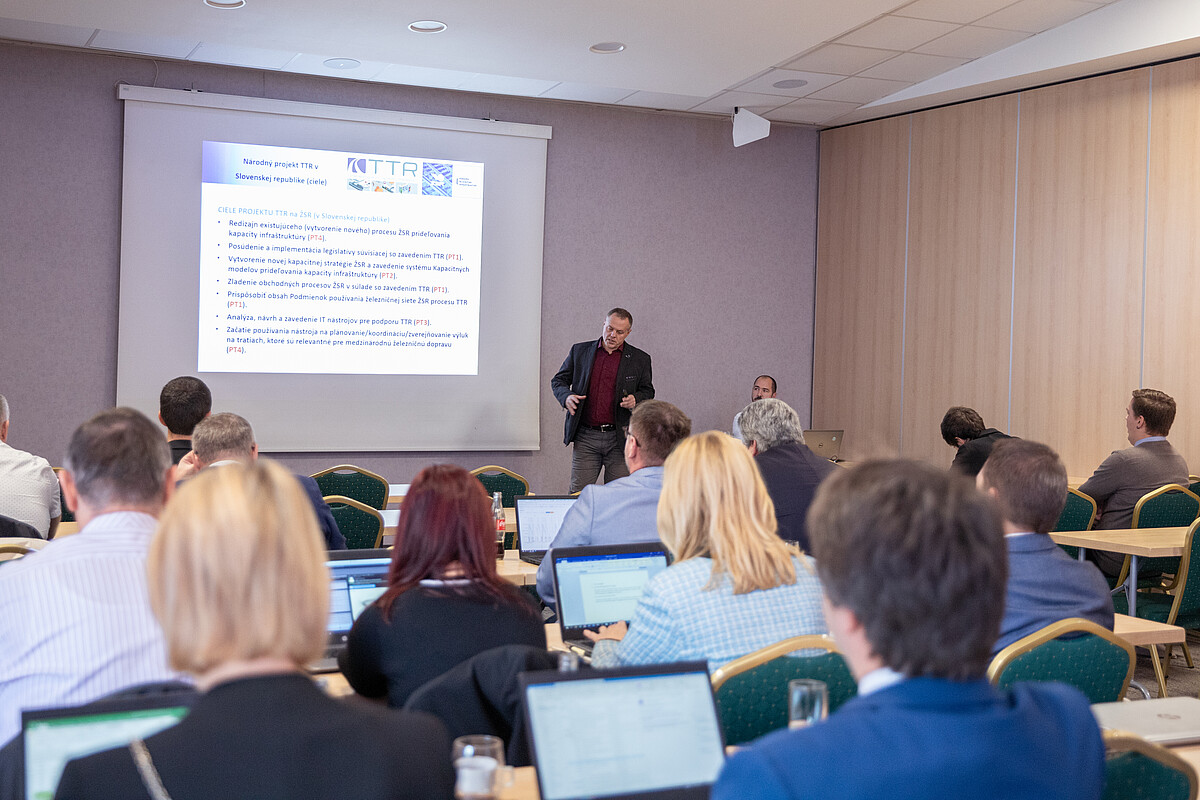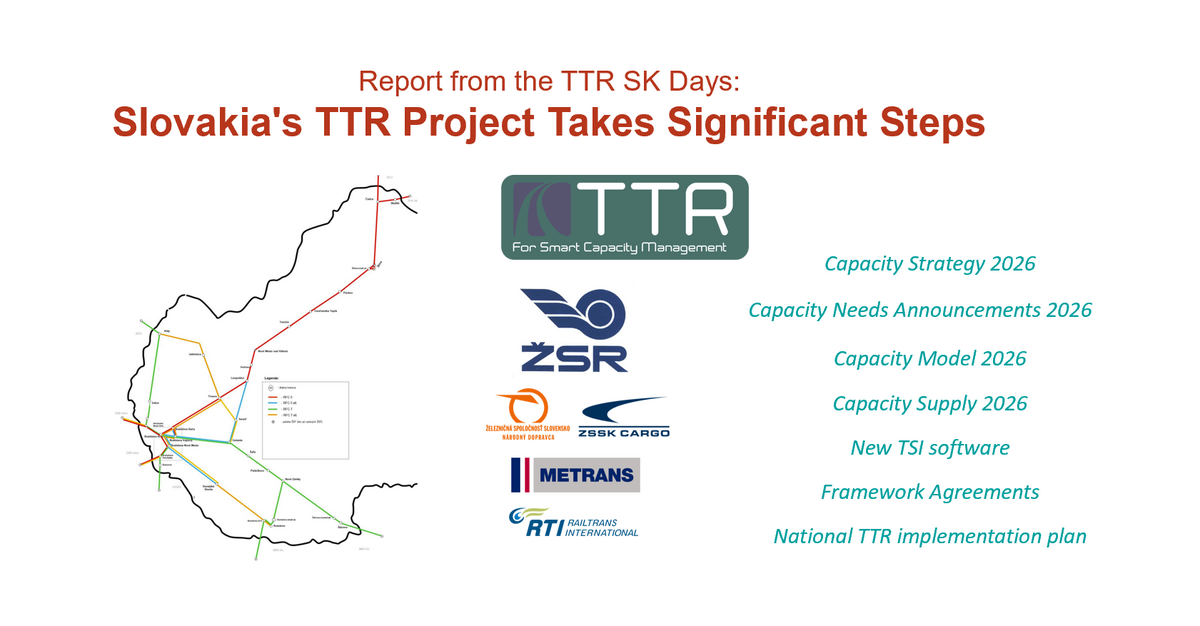The recent annual national TTR Day in Slovakia brought light to an interesting progress in the TTR implementation in Slovakia. While the infrastructure itself is in bad shape, mostly due to a long-term underfinancing and lack of priority in the transport policy, the opportunity to better plan and manage capacity is taken as a great opportunity by the national infrastructure manager, ŽSR, to make a change. When it comes to the methodological approach, ambitions and management of available scarce resources, the country draw itself as a leader in Central and East Europe and in many aspects overtakes even majority of the west. Let’s deep dive to what we can learn from the use case.
About the event
The national TTR Days in Slovakia took place 9-10 November 2023 and the organisation was a copy of the previous successful set-up, thus a two-day event. The first day was in a conference mode; ŽSR presented the state of the project which was followed by several contributions from other stakeholders such as Ministry of Transport, Forum Train Europe, RailNetEurope, Sprava Zeleznic (IM CZ). The FTE office contributed with the summary of the RU analysis of the proposed EU Regulation 443 on Use of Infrastructure (see here), an overview of the situation of TTR in the region, and overall RU feedback on the Capacity Strategies and Capacity Needs Announcements (CNA) pilot. The involvement into the discussion of the audience was on an outstanding level, furthermore, many constructive questions and insights were also given by Karol Martinček, member of the FTE Executive Board and the Board of directors of ZSSK. The second day was organised in the form of a workshop and trainings – aimed more at the operative level. ŽSR explained the Railway Undertakings and Ministry of Transport the CNA and Capacity Model process, and afterwards gave demonstration and training in ECMT, the software in which RUs were asked to send CNAs for Timetable 2026 by 10 December 2023. The presentations can be downloaded here:
- ŽSR: State of TTR Project in Slovakia in SK
- RNE: Status of European TTR Implementation in EN
- FTE: Reflexion of Regulation 443 and TTR Implementation in the Region in SK
- ŽSR: Analysis of Regulation 443 in SK
- ŽSR: Digital Capacity Management (TTR IT) in SK
- SZCZ: Experience with Capacity Strategy in CZ
- MoT SK: Funding of Infraprojects from EU funds in SK
- ŽSR: Instructions for CNAs for RUs in SK
Organisational set-up of TTR project
The TTR Project in Slovakia is in the responsibility of Železnice Slovenskej Republiky (ŽSR). The project team consists of motivated IM staff under the leadership of Jozef Dudák, the national implementation manager. ŽSR successfully applied for funds of NextGenerationEU which provides up to 100% contribution to the IM´s TTR process and IT implementation costs.
- The IM TTR team was established across various departments, depending on their involvement of various aspects such as legal, TCR, timetabling, project management and sales.
- The Steering Committee to supervise the project was established, where besides ŽSR highest management, the Ministry of Transport, Regulatory Body (Dopravny Urad) and National freight RU Association (AROS) are represented.
- The National Project Team was set-up as extension of the IM TTR Team, open for interested railway stakeholders who wish to shape the implementation. The team for instance can provide comments to the proposed internal ŽSR directives and process diagrams, test the IT systems, and provide ŽSR with regular feedback on various aspects. Three FTE members, ZSSK, ZS Cargo, Metrans Danubia, took this opportunity, as well as two non-FTE members, Railtrans and Leo Express.
- ŽSR keeps transparent and regular dialogue with Railway Undertakings. The strategical TTR Days are scheduled annually for all stakeholders, and the National Project Teams meets on quarterly basis. Furthermore, the associations representing RUs are part of the Steering Committee.
Methodological approach
In the beginning of the national project, it had to be decided whether to go in the direction of a pilot line with limited scope (as many IMs opted for) or to go directly to the overall gradual implementation, including complex change management. ŽSR opted for the more difficult path, seeing it as a means to do something about the decreasing modal share of railways, but also understanding that substantial changes are necessary to get at least small chance to meet the ambitious climate goals of the EU. Evaluating it from today’s perspective, the historical management decision seems to be a good one. Firstly, the European Commission proposed a regulation that reflects mostly the TTR elements, thus ŽSR is driving national railway stakeholders towards high awareness and preparedness for inevitable changes in the future, making it realistic to implement by the future legal enforcement deadlines. Secondly, the Ministry of Transport expressed support for ŽSR’s ambition and prioritised the ŽSR application for 100% implementation funding. Further activities are:
- Legal assessment of TTR was prepared, identifying elements which are not in conflict with national and EU legislation. The IM does not wait until the EU law makes all TTR elements mandatory, but rather tries to actively work with those parts that are not in contradiction – thus possible to be implemented.
- National TTR Feasibility study for TTR process and IT (DCM) was executed (available only in Slovak) showing Benefit/Cost ratio of 3.05 on a 16-years horizon.
- Process implementation in form of IM Directives was selected. The change management experts identified within the IM structure which departments are in possession of which information and set up process diagrams and internal routines to bring TTR elements to life. The proposed internal IM directives for Capacity Strategy, Capacity Model and CNAs were already approved by the IM management.
- Although the EU funding funded some of the IMs’ personnel costs, the implementation of the TTR elements is at this stage very resource demanding, due to unfinished development of International and national IT tools and significant amount of manual work. ŽSR thus decided to gradually implement TTR, increasing the geographical coverage yearly with new lines. For timetable 2025, main and re-routing lines of RFC 7 are in the scope, timetable 2026 brings extension to RFC 5 lines. In order to limit impact on RUs, they are asked to submit CNAs only for new and changed traffic.
State of implementation
ŽSR is aiming to catch up with RNE’s overall TTR implementation timeline. Due to a shortage of resources this is a gradual process, but the gap is step by step closing. The dates for Capacity Strategy, Model and Supply will harmonise fully for Timetable 2027, while the TCR publication dates might take longer.
- Capacity Strategy 2025 is published in English, draft Capacity Strategy 2026 in Slovak language is under consultation, while Capacity Strategy 2027 would be available in the first quarter of 2024.
- While Capacity Model 2025 are planned to be published still this year, the RUs were asked to provide Capacity Needs Announcements (CNAs) for 2026 by 10 December 2023, via ECMT software. Considering the feedback of RUs and RNE-FTE Groups, ŽSR designed the CNA process as a dialogue, in March all RUs are invited for an exchange, where ŽSR would explain RUs which CNAs cannot be fully considered in their Capacity Models, why it is like this, and mutually seek with them for alternatives.
- ŽSR stated the plan to publish Capacity Supply Plan for 2025 before the annual path request deadline, due to high amount of manual work – the scope is limited for main lines of current RFC 7 (Supply would include both passenger and freight products).
- ŽSR interprets the proposed Regulation 443 as bringing mandatory implementation of Digital Capacity Management (DCM) in 2026, which is an ambitious, but not totally unrealistic – most of the components might be in production. ŽSR successfully connected via interface as one of the first IMs with RNE TCR tool. The connection between ŽSR and Train Information System (TIS), Path Coordination System (PCS) are in test, same as the new timetabling system of ŽSR (KIS) which would become compatible with DCM and TAF/TAP TSI standards. Besides that, ŽSR plans to launch the tender on own strategic/advance planning software next year, this is an extra motivation for the stakeholders to test ECMT – to get learnings for the needed functional requirements for this IT. The implementation of DCM is fully funded by the EU funds.
- ŽSR also commented on their work to prepare usage of Framework Agreements for multi-annual capacity allocation, which is envisaged to used more often by the proposed EU Regulation 443.

